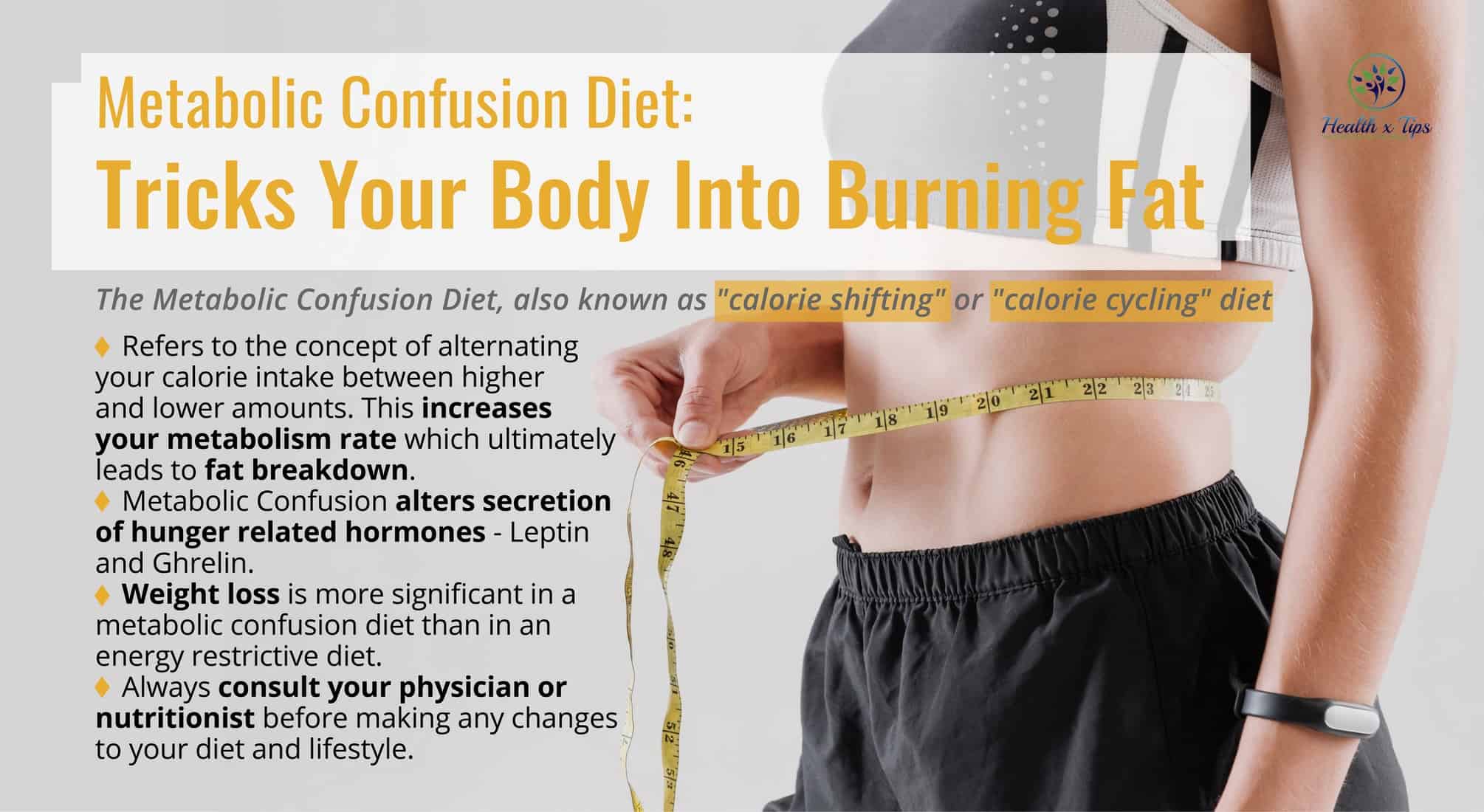Obesity has become a major public health crisis in most of the developed and developing countries. It causes severe personal, social, and healthcare burdens. According to a report published in February 2020 by the Center for Disease Control, USA, more than 42% of adults in the country are obese, and more than 9% of adults are severely obese. A number of studies have also reported that obesity and severe obesity are the major causes of coronary heart disease and end-stage renal disease.
Dieting is strongly recommended by physician and public health experts as the most effective means to maintain a lean body weight and as the remedy for overweight. However, anyone practicing a diet knows how difficult it is to restrain oneself from eating what you love. If you are one of them, you may find a metabolic confusion diet easier to follow and adhere to. However, the question remains “is metabolic confusion diet effective?” If so, “how does it work?”
In this article, we will explore what science says about the metabolic confusion diet and how it can help you maintain a lean body weight and shed excess fat.

WHAT IS A METABOLIC CONFUSION DIET?
Metabolic confusion diet is, more aptly, termed as ‘calorie shifting’ or ‘calorie cycling’ diet. It is based on the assumption that alternating between high and low calorie intake from one day to the next increases your metabolism rate which leads to fat breakdown. For instance, in a metabolic confusion diet, you can consume 2000 calories in a day and then shift to a 1200 calorie diet the next day.
In practice, you can plan a metabolic confusion diet plan on a weekly or monthly basis. In a two-week diet program, you may take low energy meals according to your height and weight for 11 days and then switch to a higher calorie diet for 3 days. During the high-energy period, be mindful that you should avoid junk food under any circumstances, period and maintain a balanced diet that will ensure an adequate supply of all nutrients that your body needs to meet the daily requirements.
The cycle goes on until you achieve the desired result. In a monthly metabolic confusion diet program, the low energy and high energy intake period can be set for 3 weeks and 1 week, respectively.
HOW METABOLIC CONFUSION DIET TRICKS THE BODY INTO BURNING FAT?
Have you noticed that there are people who eat as much as they like without putting on a single kilogram of weight? And some people don’t lose a single kilogram of weight no matter how hard they diet. Have you ever thought about why this happens?
Well, it’s all about the ‘metabolic rate’. Metabolism is the process of converting food into energy by your body. People with high metabolic rates need more energy to maintain physiological and biological functions. As a result, less energy is available to be deposited as fat. Moreover, if the energy intake is sufficiently low and does not meet the daily energy demand, in such a case, the body starts producing its energy by breaking fat.
People with a low metabolic rate, on the other hand, require less energy to maintain body functions. Consequently, the intake of even a slightly higher amount of energy than required tends to be deposited as fat which leads to increase in weight.
The Metabolic Rate Determines
Energy Utilization and Fat Deposition
When your body gets a high energy supply, mainly in the form of carbohydrates present in your food, the metabolic rate is increased. Your body breaks down some of the carbohydrates to produce energy. The rest of the carbohydrates is deposited in your body as fat. In the case of low energy intake, the reverse happens. Metabolic rate is reduced to balance the body’s energy requirement and the available amount of energy. However, studies have demonstrated that your body does not change to a low metabolic rate immediately when you switch to low energy intake following a high energy intake period. Instead, it maintains the high metabolic rate achieved during the high energy intake period for days or even weeks. This bodily response mechanism of intermittent high and low energy supply is not yet clearly understood. Hence, the term ‘metabolic confusion’ is used to describe it.
Metabolic Confusion Leads to
Increased Breakdown of Fat
The high metabolic rate and the low energy supply during metabolic confusion together leads to a negative balance of energy supply and energy requirement in your body. So, it starts producing energy by breaking down the deposited fat to meet the shortage of energy supply in the form of food.
Metabolic Confusion Alters Secretion of
Hunger Related Hormones
Leptin and ghrelin are two hormones produced and secreted by cells in your bowel. They are involved in controlling food intake and energy metabolism. Leptin controls food intake by diminishing hunger. As a consequence, the deposition of fat is also reduced. However, when you lose weight, a low level of Leptin causes a huge appetite which makes it difficult for dieters to adhere to dieting.
On the other hand, Ghrelin, also known as the hunger hormone, stimulates appetite and increases food intake, thus increasing fat deposition and body weight.
A study carried out on human volunteers by Scientists at the University of Oxford, demonstrated that during the high energy intake period, Leptin’s plasma level increases significantly and Ghrelin level is reduced substantially.
BENEFITS OF A METABOLIC CONFUSION DIET
Weight Loss is More Significant in a
Metabolic Confusion Diet than
in an Energy Restrictive Diet
In a study comparing calorie shifting diet and calorie restriction diet, volunteers in a metabolic confusion diet received 45% less calorie and the restrictive group received 55% fewer calories. Despite higher energy intake, weight loss was more significant in the calorie shifting group than the calorie-restrictive group, who consumed fewer calories.
Metabolic Confusion Diet is More Satisfying
It has been reported that compared to the energy restriction diet, participants in the metabolic confusion diet are more satisfied and less hungry. During the high energy intake period, secretion of the hunger hormone ghrelin is reduced significantly. Moreover, the secretion of Leptin also increases significantly. As a consequence, it becomes easier to continue dieting.
Metabolic Confusion Diet is Easier to Adhere to
Studies have demonstrated that fewer dieters give up dieting while on a metabolic confusion diet. For instance, one study reported that drop out in a 6-week diet program was only 15% in the metabolic confusion diet group. On the other hand, in the restrictive diet group, the dropout was 36%.
IS THERE ANY RISK IN A METABOLIC CONFUSION DIET PLAN?
Before you start a metabolic confusion diet, you should consult with your physician or nutritionist. Suppose you have any underlying health condition, such as deficiency of vitamins or minerals. In that case, it should be carefully evaluated and measures should be taken not to aggravate the condition.
Most importantly, you need to be sure to have enough energy input to maintain your everyday lifestyle. Your nutritionist can suggest meals that will suit you the best. Always consult a healthcare professional or your doctor before making any changes to your diet or lifestyle.
WHAT CAN YOU EAT ON A METABOLIC CONFUSION DIET?

There is no strict rule regarding what you can eat during metabolic confusion dieting. However, it is strongly recommended that you stick to healthy, balanced diets that will energize you from within. During the planning of meals, calculate the calorie intake. Ideally, you should take about 2000 calories per day during the high energy period. During the low energy intake days, you should take about 1200 calories per day. You can plan a low-calorie metabolic confusion diet plan by cutting the carbohydrates from your meals and adding lots of vegetables and fruits. However, energy intake will vary according to your weight, height, age, and the type of work you perform daily.
CAN YOU EXERCISE WHILE ON A METABOLIC CONFUSION DIET?
Any diet regimen’s objective, including metabolic confusion, is to reduce energy intake and increase energy utilization. Exercise while on a metabolic confusion diet will increase the energy expenditure and help you attain your goal faster.
However, you should not stress your body too much during the low energy intake days. Instead, light exercise like walking and aerobics can produce a satisfactory result. However, during the high energy intake periods, you can exercise heavily to help burn the access energy you consume.
There are many diet regimens that can help you lose weight. Be aware to choose the one that suits you best, in terms of efficiency, ease to adhere and the benefits it brings to you. You should also keep up with your lifestyle while selecting a metabolic confusion dieting method.
KEY TAKEAWAYS









0 Comments